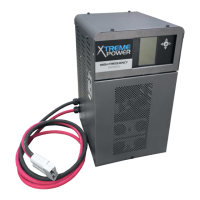6
TABLE 1-1
Line Amperes Disconnect Switch Fuse Size Amps
000.0 - 02.5 30A 05
003.0 - 04.5 30A 07
005.0 - 07.5 30A 10
008.0 - 11.0 30A 15
011.5 - 15.5 30A 20
016.0 - 18.0 30A 25
018.5 - 22.0 30A 30
022.5 - 27.0 60A 35
027.5 - 32.0 60A 40
032.5 - 40.0 60A 50
040.5 - 48.0 60A 60
048.5 - 64.0 80A 80
065.0 - 80.0 100A 100
081.0 - 95.0 125A 125
096.0 - 125.0 150A 150
1.4. AC Service Requirements
Follow local code requirements if they are different than the instructions in this manual. Refer to Table 1-1, to
determine the correct ratings for the AC cable, AC fuses, and AC service disconnect switch for the line
amperes as listed on the nameplate of the charger for the available AC voltage.
“CAUTION” – Risk of fire. Use only on circuits provided with 30 amperes branch circuit protection in
accordance with the National Electrical Code, NFPA70.
For voltages up to 240, use a 240 volt disconnect switch.
For voltages greater than 240 to 600, use a 600 volt disconnect switch.
Three conductors and ground wire required for three-phase
1.5. Connecting AC Service to the Charger
Three-Phase Models
Connect the AC service to the L1, L2 and L3 terminals located on the AC connection block.
1.6 Grounding the Charger
The charger must be grounded to the AC system ground for personnel safety.
The green ground wire in the AC input wiring must be connected to the charger ground stud identified by a
green dot and ground symbol.
1.7 Battery Connector and Charging Cable
Verify that the connectors on both the battery and the charger are attached so that the positive
output terminal of the charger is connected to the positive battery terminal.
CAUTION: If the polarity is reversed, the DC fuse will blow.
If in doubt, check the polarity with a DC voltmeter.

